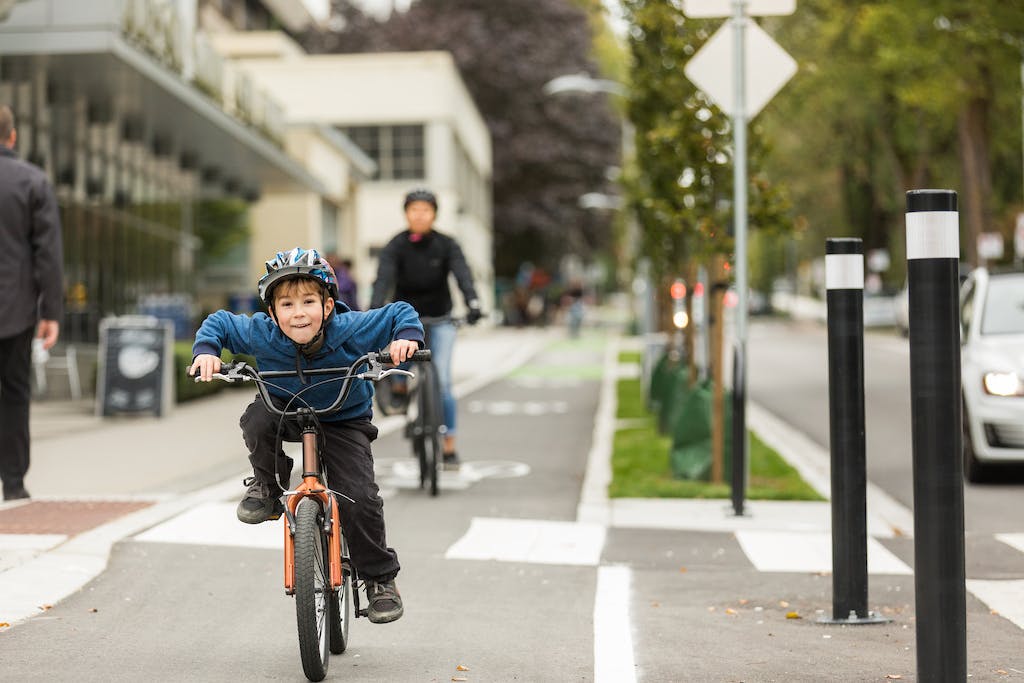What Could Biden’s Infrastructure Plan Mean for Bikes?
By: Noa Banayan, PeopleForBikes federal affairs manager

On March 31, President Biden released his administration’s $2 trillion infrastructure proposal, the American Jobs Plan, offering a wide-reaching policy and funding package including everything from transportation, broadband, water resources, manufacturing, clean energy and more. The numbers are big and bold, and the vision for more sustainable systems and communities are in line with our 2021 Federal Agenda for Active Transportation.
It’s important to know that this is only a proposal — what the administration would like to see Congress prioritize in their legislative work to address America’s many infrastructure needs — not a final product. At PeopleForBikes, we’re working with policymakers and our partners to fill in the details. Much continues to be debated in Congress, namely the scope of the plan and how they’ll fund such a broad infrastructure package.
The sections of the American Jobs Plan that would support bike infrastructure, the bike industry and increased bicycling:
1) $621 billion for transportation overall, with a fixing them right policy to enhance safety and resilience with all users in mind and a focus on limiting emissions and reducing congestion.
- This includes $20 billion to improve road safety for all users, including increases to existing safety programs and a new Safe Streets for All program to fund state and local vision zero plans and other improvements to reduce crashes and fatalities, especially for cyclists and pedestrians. The funding for vulnerable road user safety is critical, and if the Safe Streets for All program comes to pass, it should be used to fund protected biking and walking infrastructure that separates vulnerable road users from cars.
- Also included is $174 billion to help grow the electric vehicle market with a national network of 500,000 EV chargers by 2030. As policies to support electric vehicle adoption expand, we’re pushing for the inclusion of electric bicycle incentives (like the E-BIKE Act) to support an efficient, zero-emission mode of transportation that also helps reduce congestion.
2) $10 billion towards a Climate Conservation Corps, putting a new, diverse generation of Americans to work conserving our public lands and waters, bolstering community resilience and advancing environmental justice. PeopleForBikes supports the expansion of a modern conservation corps because of the potential to create jobs while building better bike trails and infrastructure.
3) $50 billion to establish an office within the Department of Commerce dedicated to monitoring domestic industrial capacity and funding investments to support production of critical goods, plus $52 billion to invest in modernizing America’s supply chains and existing capital access programs, with a focus on rural manufacturing and clean energy. Given the myriad of positive economic, health and environmental benefits communities experience when bicycling increases, we see bikes as a uniquely important product for the federal government to invest in from a manufacturing standpoint. You can read more about how we’d like to work with this administration and Congress to support bicycle manufacturers and the push towards more domestic capacity in our 2021 Trade Agenda.
There’s a lot more detail that we’d like to see included in a visionary transportation bill and infrastructure package, so we’re working with policymakers and our partners at the federal level to turn these asks into law. Check out the letters we’ve sent and signed outlining our priorities:
- PeopleForBikes Reauthorization Requests to the Senate Environment and Public Works Committee
- PeopleForBikes Reauthorization Requests to the House Transportation and Infrastructure Committee
- Signed the Rails-to-Trails Conservancy’s letter in support of the Connecting America’s Active Transportation System Act
Bikes support economic recovery, connect people to essential services and their communities, reduce emissions, promote positive health outcomes and enhance mobility for all Americans — but only when we choose to invest in safe infrastructure and commit to equitable access.
